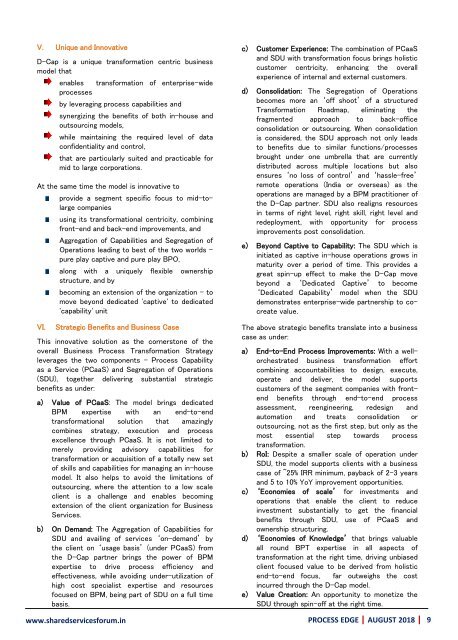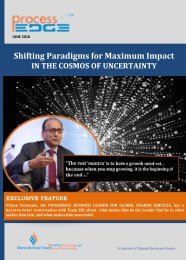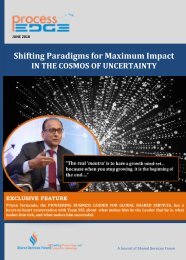SSF's Journal - Aug'18
Create successful ePaper yourself
Turn your PDF publications into a flip-book with our unique Google optimized e-Paper software.
V. Unique and Innovative<br />
D-Cap is a unique transformation centric business<br />
model that<br />
enables transformation of enterprise-wide<br />
processes<br />
by leveraging process capabilities and<br />
synergizing the benefits of both in-house and<br />
outsourcing models,<br />
while maintaining the required level of data<br />
confidentiality and control,<br />
that are particularly suited and practicable for<br />
mid to large corporations.<br />
At the same time the model is innovative to<br />
VI.<br />
provide a segment specific focus to mid-tolarge<br />
companies<br />
using its transformational centricity, combining<br />
front-end and back-end improvements, and<br />
Aggregation of Capabilities and Segregation of<br />
Operations leading to best of the two worlds -<br />
pure play captive and pure play BPO,<br />
along with a uniquely flexible ownership<br />
structure, and by<br />
becoming an extension of the organization - to<br />
move beyond dedicated 'captive' to dedicated<br />
'capability' unit<br />
Strategic Benefits and Business Case<br />
This innovative solution as the cornerstone of the<br />
overall Business Process Transformation Strategy<br />
leverages the two components - Process Capability<br />
as a Service (PCaaS) and Segregation of Operations<br />
(SDU), together delivering substantial strategic<br />
benefits as under:<br />
a) Value of PCaaS: The model brings dedicated<br />
BPM expertise with an end-to-end<br />
transformational solution that amazingly<br />
combines strategy, execution and process<br />
excellence through PCaaS. It is not limited to<br />
merely providing advisory capabilities for<br />
transformation or acquisition of a totally new set<br />
of skills and capabilities for managing an in-house<br />
model. It also helps to avoid the limitations of<br />
outsourcing, where the attention to a low scale<br />
client is a challenge and enables becoming<br />
extension of the client organization for Business<br />
Services.<br />
b) On Demand: The Aggregation of Capabilities for<br />
SDU and availing of services ‘on-demand’ by<br />
the client on ‘usage basis’ (under PCaaS) from<br />
the D-Cap partner brings the power of BPM<br />
expertise to drive process efficiency and<br />
effectiveness, while avoiding under-utilization of<br />
high cost specialist expertise and resources<br />
focused on BPM, being part of SDU on a full time<br />
basis.<br />
www.sharedservicesforum.in<br />
c) Customer Experience: The combination of PCaaS<br />
and SDU with transformation focus brings holistic<br />
customer centricity, enhancing the overall<br />
experience of internal and external customers.<br />
d) Consolidation: The Segregation of Operations<br />
becomes more an ‘off shoot’ of a structured<br />
Transformation Roadmap, eliminating the<br />
fragmented approach to back-office<br />
consolidation or outsourcing. When consolidation<br />
is considered, the SDU approach not only leads<br />
to benefits due to similar functions/processes<br />
brought under one umbrella that are currently<br />
distributed across multiple locations but also<br />
ensures ‘no loss of control’ and ‘hassle-free’<br />
remote operations (India or overseas) as the<br />
operations are managed by a BPM practitioner of<br />
the D-Cap partner. SDU also realigns resources<br />
in terms of right level, right skill, right level and<br />
redeployment, with opportunity for process<br />
improvements post consolidation.<br />
e) Beyond Captive to Capability: The SDU which is<br />
initiated as captive in-house operations grows in<br />
maturity over a period of time. This provides a<br />
great spin-up effect to make the D-Cap move<br />
beyond a ‘Dedicated Captive’ to become<br />
‘Dedicated Capability’ model when the SDU<br />
demonstrates enterprise-wide partnership to cocreate<br />
value.<br />
The above strategic benefits translate into a business<br />
case as under:<br />
a) End-to-End Process Improvements: With a wellorchestrated<br />
business transformation effort<br />
combining accountabilities to design, execute,<br />
operate and deliver, the model supports<br />
customers of the segment companies with frontend<br />
benefits through end-to-end process<br />
assessment, reengineering, redesign and<br />
automation and treats consolidation or<br />
outsourcing, not as the first step, but only as the<br />
most essential step towards process<br />
transformation.<br />
b) RoI: Despite a smaller scale of operation under<br />
SDU, the model supports clients with a business<br />
case of ~25% IRR minimum, payback of 2-3 years<br />
and 5 to 10% YoY improvement opportunities.<br />
c) ‘Economies of scale’ for investments and<br />
operations that enable the client to reduce<br />
investment substantially to get the financial<br />
benefits through SDU, use of PCaaS and<br />
ownership structuring.<br />
d) ‘Economies of Knowledge’ that brings valuable<br />
all round BPT expertise in all aspects of<br />
transformation at the right time, driving unbiased<br />
client focused value to be derived from holistic<br />
end-to-end focus, far outweighs the cost<br />
incurred through the D-Cap model.<br />
e) Value Creation: An opportunity to monetize the<br />
SDU through spin-off at the right time.<br />
PROCESS EDGE | AUGUST 20<strong>18</strong> |<br />
9





